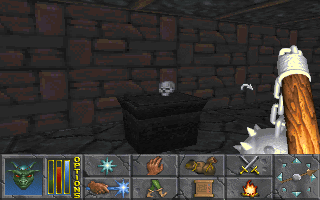So after Friday’s post about The Elder Scrolls Online and how it doesn’t really “feel” like an Elder Scrolls game, I decided to start playing the only game of the Elder Scrolls series I haven’t played yet: Daggerfall.
Long ago I played the game Arena, my first foray into The Elder Scrolls, which was easy as it is the first title of the series. I loved it. As a role playing game, it was all about the exploration and was one of the first real games where I could just go off in any direction and find adventure. Sure, procedurally generated and nothing but dungeon crawl after dungeon crawl adventure, but adventure nonetheless. Story took such a backseat that I really didn’t know what the story of Arena was. There was something about finding staff pieces and putting them together, some big bad guy. That’s about all I remember. I never completed Arena, though, the most I ever got was three staff pieces.
But still, that taste was enough. The pure freeform exploration, the fantastic loot, heard about only through rumors near a local tavern, and having to hunt down the exact locations. The freeform magic, creating your own spells with a multitude of different effects. The absolutely staggeringly humongous world that was Tamriel.
Over time, and with latest iterations, the story of The Elder Scrolls has turned front and center. Morrowind shaved down the land size considerably, and traded the full continent for one province and a handful of cities. Morrowind still had a decent number of guilds, though. Oblivion comes along and really ramps up the story, but at the expense of guilds. There’s only a handful now. Finally we have Skyrim, which has as much of a story as Oblivion and as many guilds, but rewards exploration a lot more as little side quests are everywhere. It also brings back the procedurally generated quests so that, technically, it never ends. In other words the series has shrunk over time, story has become a much greater focus, but the tenets of exploration, skill building, freeform character building, and open worlds still hasn’t left.
Daggerfall has a story, I’m sure. I’ve read the books all about the “Warp in the West” which refers to the events from Daggerfall. It retains a lot from Arena as far as dialogue with NPCs, towns, and the like, but then takes a huge number of steps forward when it comes to guilds. The number of guilds is stunningly ridiculous (There are 6 categories of factions, but each category has multiple branches). Also, this is the first game of the series to chop down the focus size to something smaller, focusing on the region of the Illiac Bay, High Rock and Hammerfell.

This map puts Daggerfall at 62,394 sq. mi. in size, so it is disputable the main size… but even this puts the game world at 3,900 times the size of Oblivion. (click to enlarge)
However, making the focused region smaller, they did NOT make the game world smaller. In fact, it is considered the largest game world of any game, only now being contested by games like Minecraft that can procedurally generate forever. Some stats on Daggerfall, by Bethesda: The size of the game world is similar to the size of Great Britain, 88,745 sq. mi., featuring 15,000 towns, cities, villages, and dungeons, and 750,000+ NPCs. Walking from one town to another in the game could literally take hours. Hours!
I don’t know how far I’m going to get, if I’ll encounter any real story or not, but I guess we’ll see.
// Ocho
P.S. – This also doesn’t mean I’m necessarily finished Game 1, Gabriel Knight, I’m just taking a break from it. You know how it is.


